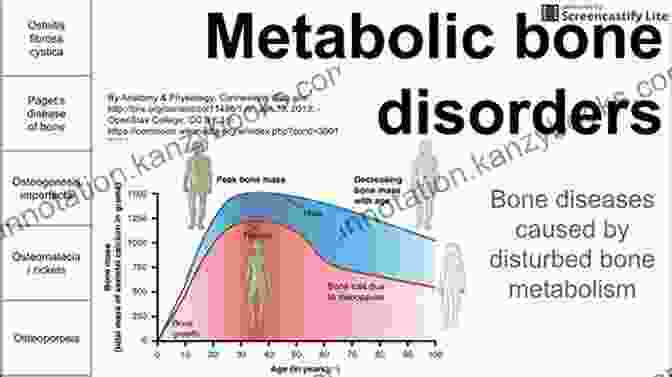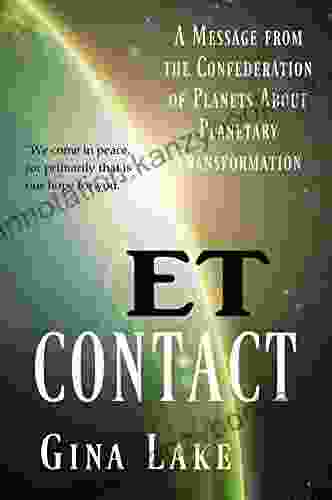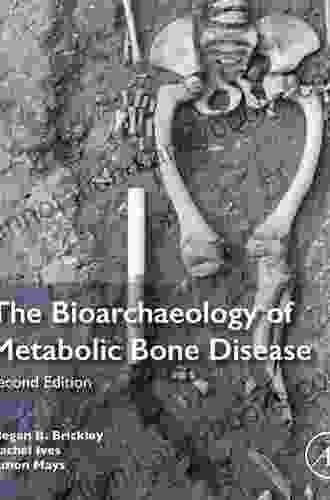The Bioarchaeology of Metabolic Bone Disease: A Comprehensive Exploration


5 out of 5
| Language | : | English |
| File size | : | 45204 KB |
| Text-to-Speech | : | Enabled |
| Enhanced typesetting | : | Enabled |
| Word Wise | : | Enabled |
| Print length | : | 316 pages |
| Screen Reader | : | Supported |
Bioarchaeology, the study of human remains from archaeological contexts, provides invaluable insights into the health and well-being of past populations. Among the various pathological conditions that can be identified in skeletal remains, metabolic bone diseases hold particular significance. These conditions, which result from an imbalance in bone metabolism, can have profound implications for an individual's health and quality of life.
In this article, we will delve into the bioarchaeology of metabolic bone disease, exploring the various types of these conditions, their causes and consequences, and the insights they can provide into the lives of ancient populations. We will also highlight recent advances in research and discuss the challenges and opportunities that lie ahead in this fascinating field.
Types of Metabolic Bone Disease
Metabolic bone diseases can be broadly classified into two main types: osteopenia and osteoporosis. Osteopenia refers to a decrease in bone mass, while osteoporosis is a more severe condition characterized by both decreased bone mass and impaired bone strength. These conditions can be caused by a variety of factors, including:
- Nutritional deficiencies (e.g., vitamin D, calcium)
- Hormonal imbalances (e.g., parathyroid hormone, estrogen)
- Genetic disFree Downloads (e.g., osteogenesis imperfecta)
- Age-related changes
- Certain medications
The most common metabolic bone disease in archaeological populations is osteoporosis, which is often associated with aging and postmenopausal women. However, osteoporosis can also occur in younger individuals due to factors such as malnutrition or hormonal imbalances.
Causes and Consequences of Metabolic Bone Disease
Metabolic bone diseases can have a wide range of consequences, depending on the severity of the condition. In mild cases, osteopenia may only cause minor symptoms such as bone pain and weakness. However, in more severe cases, osteoporosis can lead to debilitating fractures, disability, and even death.
The consequences of metabolic bone disease can extend beyond the individual level. For example, osteoporosis has been linked to increased healthcare costs, reduced productivity, and social isolation. Additionally, metabolic bone diseases can provide insights into the overall health and well-being of ancient populations, as they can reflect dietary deficiencies, nutritional stressors, and access to healthcare.
Bioarchaeological Investigation of Metabolic Bone Disease
Bioarchaeologists use a variety of techniques to identify and study metabolic bone diseases in archaeological populations. These techniques include:
- Gross examination: Examination of skeletal remains with the naked eye can reveal signs of metabolic bone disease, such as bone thinning, fractures, and deformities.
- Radiography: X-rays can be used to visualize bone structure and identify changes consistent with metabolic bone disease.
- Histological analysis: Examination of bone tissue under a microscope can provide detailed information about bone structure and remodeling.
- Chemical analysis: Analysis of bone chemistry can provide insights into dietary patterns, nutritional deficiencies, and metabolic processes.
By combining these techniques, bioarchaeologists can gain a comprehensive understanding of the prevalence, distribution, and causes of metabolic bone disease in ancient populations.
Insights from the Bioarchaeological Record
Bioarchaeological studies of metabolic bone disease have provided valuable insights into the lives of ancient populations. For example, research has shown that osteoporosis was common in ancient Egypt and other parts of the world, suggesting that dietary deficiencies and hormonal imbalances were widespread in these populations.
Additionally, bioarchaeological studies have revealed that metabolic bone disease was often associated with social inequality. For example, in some prehistoric societies, individuals from higher social classes had lower rates of osteoporosis, suggesting that access to healthcare and nutrition played a significant role in the development of these conditions.
Challenges and Opportunities in the Bioarchaeology of Metabolic Bone Disease
While bioarchaeological research on metabolic bone disease has made significant progress, several challenges remain. These challenges include:
- Differential diagnosis: Distinguishing between metabolic bone disease and other conditions that can affect bone, such as infectious diseases or trauma.
- Determining the etiology of the disease: Identifying the specific cause(s) of metabolic bone disease in ancient populations can be difficult due to the lack of historical records and the fragmentary nature of archaeological data.
- Population-level studies: Conducting population-level studies of metabolic bone disease can be challenging due to the scarcity of well-preserved skeletal remains in archaeological contexts.
Despite these challenges, there are also exciting opportunities for future research in the bioarchaeology of metabolic bone disease. These opportunities include:
- Advanced imaging techniques: The use of advanced imaging techniques, such as micro-computed tomography (micro-CT),can provide detailed images of bone structure and identify even subtle changes consistent with metabolic bone disease.
- Molecular analysis: Molecular analysis of bone tissue can provide insights into genetic factors and metabolic processes involved in metabolic bone disease.
- Interdisciplinary collaboration: Collaborations between bioarchaeologists, medical anthropologists, and other researchers can provide a more comprehensive understanding of metabolic bone disease in ancient populations.
The bioarchaeology of metabolic bone disease is a fascinating and rapidly growing field that provides valuable insights into the health and well-being of ancient populations. By studying the skeletal remains of our ancestors, bioarchaeologists can identify and characterize metabolic bone diseases, explore their causes and consequences, and gain a better understanding of the lives and challenges faced by people in the past.
As research continues to advance, we can expect to gain even more knowledge about the prevalence, distribution, and causes of metabolic bone disease in ancient populations. This knowledge will not only contribute to our understanding of human health and disease but also provide valuable insights into the social, economic, and environmental factors that have shaped our evolutionary journey.
5 out of 5
| Language | : | English |
| File size | : | 45204 KB |
| Text-to-Speech | : | Enabled |
| Enhanced typesetting | : | Enabled |
| Word Wise | : | Enabled |
| Print length | : | 316 pages |
| Screen Reader | : | Supported |
Do you want to contribute by writing guest posts on this blog?
Please contact us and send us a resume of previous articles that you have written.
 Book
Book Novel
Novel Page
Page Chapter
Chapter Text
Text Story
Story Genre
Genre Reader
Reader Library
Library Paperback
Paperback E-book
E-book Magazine
Magazine Newspaper
Newspaper Paragraph
Paragraph Sentence
Sentence Bookmark
Bookmark Shelf
Shelf Glossary
Glossary Bibliography
Bibliography Foreword
Foreword Preface
Preface Synopsis
Synopsis Annotation
Annotation Footnote
Footnote Manuscript
Manuscript Scroll
Scroll Codex
Codex Tome
Tome Bestseller
Bestseller Classics
Classics Library card
Library card Narrative
Narrative Biography
Biography Autobiography
Autobiography Memoir
Memoir Reference
Reference Encyclopedia
Encyclopedia Stephen Bevan
Stephen Bevan Michael Shepard
Michael Shepard Mr Saju
Mr Saju Michael Nye
Michael Nye George Seldes
George Seldes Maree Teesson
Maree Teesson George S Fichter
George S Fichter George Browne Md
George Browne Md Richard Stim
Richard Stim Rebecca Shelley
Rebecca Shelley Jennifer Heard
Jennifer Heard Georg Weidinger
Georg Weidinger Paris Tosen
Paris Tosen Gil Carlson
Gil Carlson Mike Andrews
Mike Andrews Eric H Cline
Eric H Cline George Bradshaw
George Bradshaw Sue Hitzmann
Sue Hitzmann Anna Digilio
Anna Digilio Gerard E Mullin
Gerard E Mullin
Light bulbAdvertise smarter! Our strategic ad space ensures maximum exposure. Reserve your spot today!

 Levi PowellLose Weight, Naturally: Discover the Life-Changing Secrets of Slim For Life...
Levi PowellLose Weight, Naturally: Discover the Life-Changing Secrets of Slim For Life... Junichiro TanizakiFollow ·8.3k
Junichiro TanizakiFollow ·8.3k Bret MitchellFollow ·3.6k
Bret MitchellFollow ·3.6k Clark CampbellFollow ·5k
Clark CampbellFollow ·5k Ted SimmonsFollow ·16.7k
Ted SimmonsFollow ·16.7k Efrain PowellFollow ·15.7k
Efrain PowellFollow ·15.7k Victor HugoFollow ·6k
Victor HugoFollow ·6k Oscar BellFollow ·11.7k
Oscar BellFollow ·11.7k Martin CoxFollow ·3.6k
Martin CoxFollow ·3.6k

 Gary Reed
Gary ReedFix It & Forget It Slow Cooker Dump Dinners &...
Are you ready to...

 Corey Hayes
Corey HayesUnlock the Secrets of Addictive Behavior: Dive into the...
In the face of the prevalent global addiction...

 Harvey Bell
Harvey BellHistorical Atlas of Indonesia by Robert Cribb: A Journey...
Embark on an...

 Allen Ginsberg
Allen GinsbergUnveiling Cosmic Truths: A Message from the Confederation...
Confederation of Planets Prepare to...

 Ernest Hemingway
Ernest HemingwaySlow Cooker Recipes 10 Ingredients Or Less And Gluten...
In the hustle and bustle of...
5 out of 5
| Language | : | English |
| File size | : | 45204 KB |
| Text-to-Speech | : | Enabled |
| Enhanced typesetting | : | Enabled |
| Word Wise | : | Enabled |
| Print length | : | 316 pages |
| Screen Reader | : | Supported |












